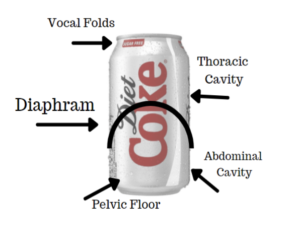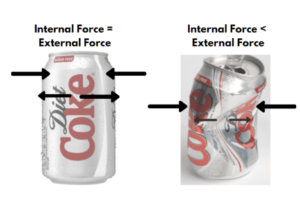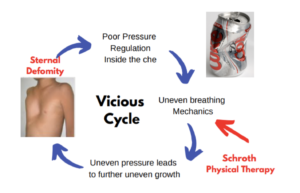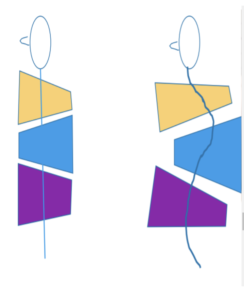What is Pectus Excavatum?
Pectus excavatum is a misshape of the chest wall that causes several ribs and the breastbone (sternum) to grow inward and form a depression in the chest. This depression gives the chest a “sunken chest” or “caved in chest” appearance. Pectus Excavatum occurs in males more than females, 3 to 1, and is often referred to as a funnel chest.

What Causes Pectus Excavatum?
We don’t know exactly what causes pectus excavatum, in fact, it appears that it might be caused by more than one factor. Pectus Excavutum can be associated with scoliosis and could have a family genetic factor. Although some patients are born with Pectus Excavatum, most notice development and significant progression of the deformity during rapid adolescent growth spurts.
Past studies have focused on the imbalance and overgrowth of the cartilage between the rib and the sternum area as one possible cause of Pectus Excavatum. Other research done by physical therapist Mary Massory focused on the internal pressure of the trunk versus the external pressure on the trunk, as another explanation for the sunken chest.

Mary Massory, P.T. describes posture control using the soda can model. In this model, the can represents the area between the vocal folds at the top and the pelvic floor at the bottom. This entire area is commonly referred to as the core or the trunk. The pressure in the can is regulated by internal and external forces. An imbalance in the forces, namely, the insufficient force pressing outwards as compared to the force pressing inwards, can lead to Pectus Excavatum.
Internal forces are provided by the muscles that support the ribcage and spine. Inability to regulate the forces could be a factor in Pectus Excavatum.
Although the exact initiating cause of Pectus Excavatum is unclear, it seems that once the sunken chest begins, a cycle of incorrect breathing mechanics causes muscle imbalances and posture imbalances. These imbalances contribute to additional difficulty regulating the correct internal pressure, which leads to additional sternal deformity. This cycle is known as the vicious cycle (see picture below). The Schroth Method of Physical Therapy can work on the muscle imbalances and postural aspects of Pectus Excavatum in the vicious cycle. Schroth PT will train the client on correct postural alignment during exercises as well as during activities of daily living. The treatment aims to halt the further collapse of the sternum and to teach clients the correct breathing mechanics.


Signs & Symptoms of Pectus Excavatum?
The main sign of Pectus Excavatum is a chest that looks sunken. Frequently Pectus Excavatum is found in the early teenage years during the most rapid period of growth. Generally, Pectus Excavatum does not cause pain or discomfort. Mild cases might be barely noticeable. However, in some cases, the sunken ribs and chest can decrease the amount of air into the lungs. In these more severe cases, it can cause difficulty breathing along with other respiratory issues including shortness of breath, frequent lung infections, and chest pain.
Severe Pectus Excavatum can cause a deep hollow in the chest that can put pressure on the lungs and heart causing additional symptoms including:
- Problems tolerating exercise
- Tiredness and decreased endurance
- Chest pain with or without exertion
- A rapid heartbeat or heart palpitations
- Frequent respiratory infections
- Coughing or wheezing with or without exercise
Physical therapy objective findings for pectus excavatum often include:
- Hyperkyphosis
- Tight pectoralis
- Decreased shoulder range of motion in flexion and external rotation
- Excessive lumbar lordosis on arm elevation
- Weak abdominals and lack of control with flaring ribs
- Weak scapular adductors
- Tight rib cage

Schroth Physical Therapy Treatment
Schroth Physical Therapy for Pectus Excavatum begins with a detailed observation of the client from the sagittal, or side on, view of the body. Consider the body as blocks stacked one above the other, as seen in the picture above. Ideally all the blocks should stack evenly on the one above or below. However, in Pectus Excavatum, we see the mid-thoracic block (blue block) shifts posterior or backwards and is no longer in line with the other blocks. This posterior shift affects the blocks both above and below (yellow and purple blocks). The upper (yellow) block, which includes the neck and shoulders, tends to round forward and downward to compensate for the backward shift of the pectus excavatum blue block. The lower pelvic (purple block) tends to shift forward and upward towards in an anterior pelvic tilt, compensating for the backward shift in the blue block.
Treatment using the Schroth Method will begin by elongation of the entire trunk, including all three blocks. We then ensure the pelvis is in correct alignment in all 3 planes, frontal, sagittal, and transverse (side to side, front and back, and rotation). Once the person is in the best alignment they begin to increase the ribcage expansion into the collapsed areas, mainly, the collapsed chest area. This ribcage expansion correlates with breath work and internal pressure to attempt to realign all 3 blocks. The treatment can progress to stretching the tight muscles and strengthening the weak muscles, but always maintaining the maximum amount of internal pressure and correct body alignment.
Surgical options are available for Pectus Excavatum. The goal for surgery is to relieve pressure on the heart and lungs as well as addressing the appearance of the chest wall.
For more information on Schroth Physical Therapy for pectus excavatum please contact www.ScoliosisPTJax.com or call (904) 372-3161.
Donnѐ
References:
- Massery M. Multisystem clinical implications of impaired breathing mechanics and postural control In :Frownfelter D, Dean E, eds. Cardiovascular and Pulmonary Physical Therapy: Evidence for practice: 5 ed. St. Lours, MO: Elsevier-Mosby: 2012:633-653
- Schreiber S, Parent EC, Moez EK, et al “The effect of Schroth exercises added to the standard of care on the quality of life and muscle endurance in adolescents with idiopathic scoliosis-an assessor and statistician blinded randomized controlled trial: SOSORT 2015 Award Winner”. Scoliosis 2015:10:24
- Pectus excavatum. Mayo Clinic, https://mayoclinic.org?diseases-conditions/pectus-excavatum/symptoms-causes/syc-20355483. Published October 13, 2018.